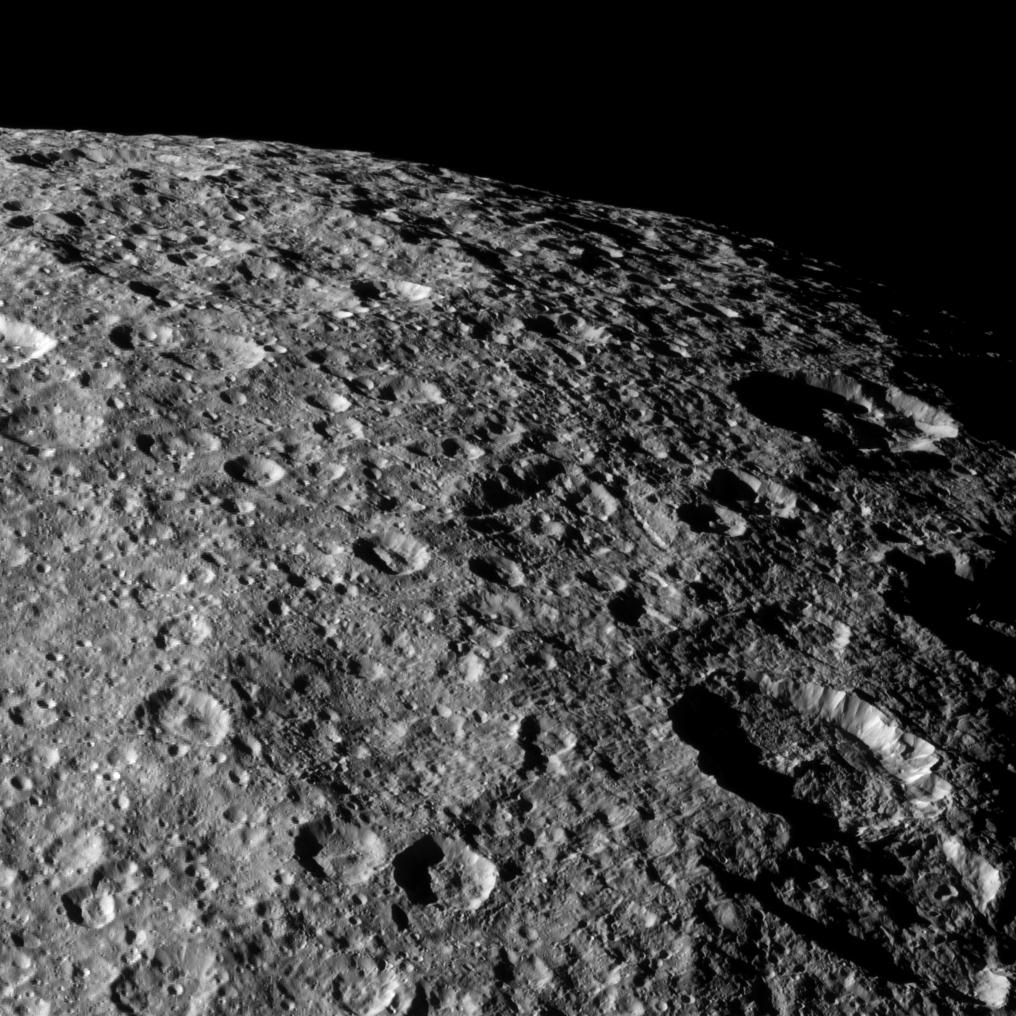NASA | JPL-Caltech | Cassini Solstice Mission | 2013 Mar 07
NASA's Cassini spacecraft will be swooping close to Saturn's moon Rhea on Saturday, March 9, the last close flyby of Rhea in Cassini's mission. The primary purpose will be to probe the internal structure of the moon by measuring the gravitational pull of Rhea against the spacecraft's steady radio link to NASA's Deep Space Network here on Earth. The results will help scientists understand whether the moon is homogeneous all the way through or whether it has differentiated into the layers of core, mantle and crust.
In addition, Cassini's imaging cameras will take ultraviolet, infrared and visible-light data from Rhea's surface. The cosmic dust analyzer will try to detect any dusty debris flying off the surface from tiny meteoroid bombardments to further scientists' understanding of the rate at which "foreign" objects are raining into the Saturn system.
Cassini will fly within about 600 miles (1,000 kilometers) of the surface. The time of closest approach is around 10:17 a.m. PST (1:17 p.m. EST). This is Cassini's fourth close flyby of Rhea.
On Feb. 10, 2015, Cassini will pass Rhea at about 29,000 miles (47,000 kilometers), but this is not considered a targeted flyby. Cassini has been in orbit around Saturn since 2004 and is in a second mission extension, known as the Solstice mission.
Rhea 'R-4' Flyby: Looking at the Internal Structure
NASA | Cassini Solstice Mission | 2013 Mar 09
This gravity flyby of Rhea was designed to understand the internal structure of Saturn’s second largest moon. Is Rhea a homogeneous body or did it differentiate into a core, mantle, and crust like the Earth? The radio science subsystem used radio waves beamed to Earth to perform precise measurements designed to answer this question.
In addition, the Cassini spacecraft's cameras gathered images of the surface at ultraviolet, infrared, and visible wavelengths. And the cosmic dust analyzer instrument attempted to detect the dusty debris that flies off the surface from tiny meteoroid bombardments. Counting these dust particles ejected from Rhea's surface helps scientists estimate the bombardment rate for the Saturn system and how often the icy rings have been polluted by particles from other places in the solar system. Understanding the contamination rate will enable scientists to improve estimates of the age of the rings.
Cassini Returns Images of Battered Saturn Moon
NASA | JPL-Caltech | Cassini Solstice Mission | CICLOPS | 2013 Mar 11
Following its last close flyby of Saturn's moon Rhea, NASA's Cassini spacecraft captured these raw, unprocessed images of the battered icy moon. They show an ancient, cratered surface bearing the scars of collisions with many space rocks. Scientists are still trying to understand some of the curious features they see in these Rhea images, including a curving, narrow fracture or graben, which is a block of ground lower than its surroundings and bordered by cliffs on either side. This feature looks remarkably recent, cutting most of the craters it crosses, with only a few small craters superimposed.
Cassini flew by Rhea at an altitude of 620 miles (997 kilometers) on March 9, 2013. This flyby was designed primarily for the radio science sub-system to measure Rhea's gravity field. During closest approach and while the radio science sub-system was measuring the icy satellite's gravity field, the imaging team rode along and captured 12 images of Rhea's rough and icy surface. Outbound from Rhea, Cassini's cameras captured a set of global images from a distance of about 167,000 miles (269,000 kilometers).
Data from Cassini's cosmic dust analyzer were also collected to try to detect any dusty debris flying off the surface from tiny meteoroid bombardments. These data will help scientists understand the rate at which "foreign" objects are raining into the Saturn system.
This was the mission's fourth close encounter with Rhea. The spacecraft will pass the moon, but at a much greater distance, in a few years.






Image Credit: NASA/JPL-Caltech/Space Science Institute
These are the Last Close-up Images of the Moon Rhea from Cassini
Universe Today | Nancy Atkinson | 2013 Mar 12
Cassini Buzzes Saturn's Frozen Moon Rhea
Discovery News | Jason Major | 2013 Mar 12

